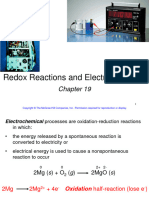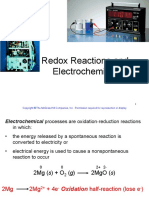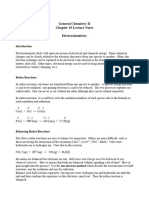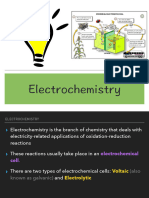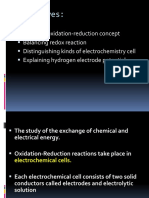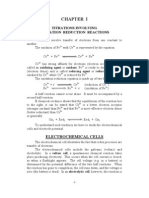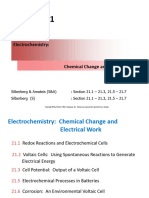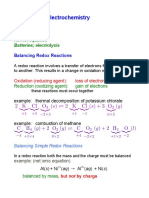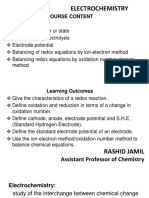ELECTROCHEMISTRY
Electrochemistry is the study of relationships between
electrical and chemical energy (involves oxidation-
reduction reactions)
Redox reactions (oxidation-reduction reactions)
Oxidation-reduction (Redox) reactions involve the
transfer of electrons from one atom to another
Oxidation is the process of losing electrons or the
increase of oxidation number (state)
Reduction is the process of gaining electrons or the
reduction of oxidation number
(Both oxidation and reduction occur simultaneously in a
redox reaction)
Consider the following reaction:
Mg(s) + 2H+(aq) → Mg2+(aq) + H2(g)
Ox. No: (0) (+1) (+2) (0)
Magnesium: Mg loses 2 electrons in the process of
forming Mg2+
Oxidation no. increases from 0 to +2
∴ Mg is oxidized to Mg2+
Hydrogen: H+ gains 2 electrons to form H2
Oxidation no. decreases from +1 to 0
∴ H+ is reduced to H2
1
�Oxidizing agent: A species that causes the oxidation
of another species (is itself reduced)
∴ H+ is an oxidizing agent
Reducing agent: A species that causes the reduction
of another species (is itself oxidized)
∴ Mg+(s) is a reducing agent
A redox reaction can be broken into two half-reactions:
Oxidation half-rxn: Mg(s) → Mg2+(aq) + 2e
Reduction half-rxn: 2H+(aq) + 2e → H2(g)
Overall reaction: Mg(s) + 2H+(aq) → Mg2+(aq) + H2(g)
Assigning oxidation numbers (states)
The following are rules for assigning oxidation
numbers in a redox reaction:
• Pure elements: Oxidation number equals 0 per atom
• Mono atomic ions: Oxidation number is equal to the
charge on the ion
• Species in a molecule or ion with constant oxidation
numbers:
- Group I elements (+1)
- Group II elements (+2)
- Group III elements (+3)
- Oxygen: -2 (except peroxides, eg -1 for H in H2O2)
- Hydrogen: +1 (except hydrides, eg -1 for H in NaH)
2
�• The sum of the positive and negative oxidation
states for neutral species equals zero
• The sum of positive and negative oxidation states
for ionic species equals the charge on the species
eg. (1) The oxidation state of sulfur for Na2S2O8
2Na + 2S + 8O = 2(+1) + 2(x) + 8(-2) = 0
The oxidation number of S = x = +7
(2) The oxidation state of Cr for Cr2O72-
2Cr + 7O = 2(x) + 7(-2) = -2
The oxidation state of Cr = x = +6
Balancing redox equations
A redox equation is balanced by the ion-electron or the
half-reaction method
The following are general steps for balancing redox
equations:
Given: MnO −4 + (COOH)2 + H+ → Mn2+ + CO2 + H2O
(In acidic medium)
(1) Separate the equation into two half-reactions (H2O
and H+ are omitted first)
Assign all atoms with oxidation numbers to
determine the reduction and the oxidation half-
reactions
3
� MnO −4 → Mn2+
(Mn = +7) (Mn = +2) (Ox no ↓: Reduction)
(COOH)2 → CO2
(C = +3) (C = +4) (Ox no ↑: Oxidation)
(2) Balance the number of atoms for all the elements
(except H and O)
The Mn atoms are already balanced
MnO −4 → Mn2+
Multiply the CO2 by 2 to balance the C atoms
(COOH)2 → 2CO2
(3) Balance the O atom by adding equivalent number
of H2O to the side with less O
Add 4 H2O molecules to the right-hand side
MnO −4 → Mn2+ + 4H2O
The O atoms are already balanced
(COOH)2 → 2CO2
(4) Balance the H atom by adding H+ to the side with
less H
Add 8 H+ ions on the left side
MnO −4 + 8H+ → Mn2+ + 4H2O
Add two H+ to the right-hand side
(COOH)2 → 2CO2 + 2H+
4
�(5) Balance the charge by adding equivalent number
of electrons to the side with the greater positive
charge (charge for 1e = –1)
Left of equation: Total charge = +7 (–1 from
MnO −4 , +8 from 8H+)
Right of equation: Total charge = +2 (from Mn2+),
∴ add 5e to the left side of the equation
MnO −4 + 8H+ + 5e → Mn2+ + 4H2O
Left of equation: Total charge = 0
Right of equation: Total charge = +2
∴ add 2e to the right side of the equation
(COOH)2 → 2CO2 + 2H+ + 2e
(6) Multiply both half-reactions by a suitable coefficient
so that the electrons cancel out upon addition of
the equations
Multiply the half-reaction by 2:
[MnO −4 + 8H+ + 5e →Mn2+ + 4H2O] × 2
Multiply the half-reaction by 5:
[(COOH)2 → 2CO2 + 2H+ + 2e] × 5
5
�(7) Add the two half-reactions together (cancel out the
electrons)
2MnO −4 + 5(COOH)2 + 6H+ → 2Mn2+ + 10CO2 + 8H2O
(This equation is for the reaction in an acidic
solution/medium)
For a reaction in a basic solution, the number of OH-
equivalent to the number of H+ (in the balanced
equation) is added to both sides of the arrows
2MnO −4 + 5(COOH)2 + 6H+ → 2Mn2+ + 10CO2 + 8H2O
Add 6OH- to both sides of the arrow:
6OH– + 2MnO −4 + 5(COOH)2 + 6H+ →
2Mn2+ + 10CO2+ 8H2O + 6OH–
(Assuming that OH– + H+ → H2O)
The equation in a basic solution becomes:
6H2O + 2MnO −4 + 5(COOH)2 →
2Mn2+ + 10CO2 + 8H2O + 6OH–
Cancel out the excess H2O and the final equation is
2MnO −4 + 5(COOH)2 → 2Mn2+ + 10CO2 + 2H2O + 6OH–
6
�The Voltaic (Galvanic) cell
The Voltaic or Galvanic cell produces electrical current
due to the electrical potential of two redox reactions
Voltaic cells consist of the following components:
o Two ‘half-cells’ containing electrolyte solutions
separated by the ‘salt bridge’ (agar containing KCl
solution packed in a U-tube)
o Electrodes dipped in their ion electrolytes connect
an external circuit to a voltmeter placed between
the two electrodes
The following figure shows the setup of a voltaic cell
consisting of a Cu half-cell and a Zn half-cell:
7
�• The anode (negative electrode) is always on the left
Oxidation reaction occurs in this half-cell
• The cathode (positive electrode) is on the right
Reduction occurs in this half-cell
A ‘cell diagram’ or ‘shorthand notation’ describes a
voltaic cell with the use of symbols
The ‘shorthand notation’ describing the Zn-Cu cell
above is
Zn(s)⏐Zn2+(1.0 M) ⏐⏐ Cu2+(1.0 M)⏐Cu(s)
The ' | ' symbol separates the electrodes from the
electrolytes and ' | | ', symbolic of the salt bridge,
separates the half-cells
8
�Electromotive force (emf) or cell potential
The emf of a cell is the difference in the electrode
potential of two half-cells measured in volts
(1 volt = 1 Joule Coulomb-1)
Ecell = Eright cell – Eleft cell
⇒ Ecathode – Eanode
For a standard cell, the potential is Eocell :
Eocell = E red
o o
(cathode) - E red (anode)
A redox reaction that has a positive cell potential (Eocell )
is spontaneous (favor products)
If Eocell is negative, the reverse reaction is spontaneous
Ecell > 0.0 V: The forward reaction is spontaneous
(Voltaic or Galvanic cell aka Battery)
Ecell = 0.0 V: There is no net flow of electrons because
the system is at equilibrium
Ecell < 0.0 V: The reverse reaction is spontaneous
(Electrolytic cell)
9
� Standard electrode potential (Eo)
The electrode potential (E) of a species depends on
the following factors:
• The nature of the species
• The concentrations of ionic species in the solution
• The partial pressures of any gases involved in the
reaction
• The temperature at which the reaction is run
The standard electrode potential (Eo) is potential
measured at standard conditions as follows:
• The concentrations of solutions are 1.0 M
• Gases present are at partial pressure of 1 atm
• Reactions occur at 298 K (25oC)
• Platinum electrode is used in non-metal half-cells
o
The standard reduction potential (E red )
o
The standard reduction potential (E red ) is the potential
under standard conditions for a reduction half-cell
The Eo value of a half-cell is determined by comparing
it with a reference electrode, aka the standard
hydrogen electrode (SHE)
10
� A standard hydrogen electrode (SHE)
The reference (half-cell) reaction of a SHE is:
o
2H+(aq) + 2e- → H2(g) E red = 0.0 Volts
o
Determining the E red of a half -cell
o
The E red of a half-cell is determined by using the Eocell
value of a cell consisting of the SHE and the desired
half-cell
Consider the setup of a standard Zn-SHE voltaic cell
(at 25oC):
Zn(s) | Zn2+ (1 M) | | H+ (1 M), H2 (1 atm) | Pt(s)
The overall cell reaction is:
Zn(s) + 2H+(aq) → Zn2+(aq) + H2(g)
Break into half-cell reactions:
Zn(s) → Zn2+(aq) + 2e- (Left anode: oxidation)
2H+(aq) + 2e- → H2(g) (Right cathode: reduction)
11
�The setup of the cell is shown in the following figure:
The cell potential (Eocell ) measured by the voltmeter is
o
0.76 Volts, thus the standard reduction potential (E red )
of zinc is calculated as follows:
Eocell = E red
o o
(cathode) - E red (anode)
o o
0.76V = E red (H2) - E red (Zn)
o
0.76V = 0.00V - E red (Zn)
o
E red (Zn) = -0.76V
o
Table of E SRP (the electrochemical series)
o
The E red values for a number of reduction half-cell
o
reactions are listed in the ‘Table of E SRP ’ (aka the
electrochemical series)
12
�The E oox or standard oxidation potential is the potential
under standard conditions for the oxidation half-cell
(the equation given in the table is reversed and the
sign of the voltage is changed)
o
eg Reduction: Cd2+(aq) + 2e → Cd(s) E red = -0.403 V
∴ Oxidation: Cd(s) → Cd2+(aq) + 2e E oox = +0.403 V
o
The half-cell with a more positive E red will more
preferentially undergo reduction
o
The half-cell with the less positive E red will more
preferentially undergo oxidation
o
E red values are generally applied in the following:
- To determine the anode and cathode of a cell
- To calculate the overall potential of a cell
- To predict the possibility of a spontaneous reaction
- To determine the relative strengths of oxidizing and
reducing agents
13
�Sample problem (Setup of a cell and overall reaction)
(a) Sketch a figure showing the setup of a standard
Zn-Cu cell
(b) Write the overall equation and determine the
standard cell potential
Solution
14
�Sample problem (spontaneity of redox reactions)
Does the following reaction produce cadmium metal?
Cd2+(aq) + Pb(s) → Cd(s) + Pb2+(aq)
o
Given: Cd2+(aq) + 2e → Cd(s) E red = -0.403 V
o
Pb2+(aq) + 2e → Pb(s) E red = -0.126 V
Solution
15
�Sample problem (relative oxidizing and reducing
strengths)
Order the following species according to increasing
reducing strengths: Mg, Sn, Cl- and I-
Solution
16
�Sample problem
A Voltaic cell is constructed using Al and Ag half-cells
o
Given: Ag+(aq) + e → Ag(s) E red = +0.799 V
o
Al3+(aq) + 3e → Al(s) E red = -1.66 V
(a) Idenify the anode and the cathode half-cell
(b) Determine the standard potential of the reaction
(c) Sketch the setup of the cell
(d) Write down the shorthand notation of the cell
(e) Write down the overall equation
Solution
17
� o
Table 1: Standard reduction potentials (E SRP )
(The series is also known as the electrochemical series)
o
Half-Reaction E red (Volts)
K+ + e- K -2.924 More
Ba2+ + 2e- Ba -2.900 easily
Ca2+ + 2e- Ca -2.760 oxidized
Na+ + e- Na -2.712 ↑
Mg2+ + 2e- Mg -2.375
H2 + 2e- 2 H- -2.230
Al3+ + 3e- Al -1.706
Mn2+ + 2e- Mn -1.040
Zn2+ + 2e- Zn -0.763
Cr3+ + 3e- Cr -0.740
S + 2e- S2- -0.508
2CO2 + 2H+ + 2e- H2C2O4 -0.490
Cr3+ + e- Cr2+ -0.410
Fe2+ + 2e- Fe -0.409
Co2+ + 2e- Co -0.280
Ni2+ + 2e- Ni -0.230
Sn2+ + 2e- Sn -0.136
Pb2+ + 2e- Pb -0.126
Fe3+ + 3e- Fe -0.036
2H+ + 2e- H2 0.000
S4O62- + 2e- 2 S2O32- 0.089
Sn4+ + 2e- Sn2+ 0.150
Cu2+ + e- Cu+ 0.158 Reducing
Cu2+ + 2e- Cu 0.340 power
O2 + 2H2O + 4e- 4OH- 0.401 increases
Cu+ + e- Cu 0.522 ↑
I3- + 2e- 3 I- 0.534
18
�MnO4- + 2H2O + 3e- MnO2 + 4OH- 0.588 Oxidizing
O2 + 2H+ + 2e- H2O2 0.682 power
Fe3+ + e- Fe2+ 0.770 increases
Hg22+ + 2e- Hg 0.796 ↓
Ag+ + e- Ag 0.800
Hg2+ + 2e- Hg 0.851
H2O2 + 2e- 2OH- 0.880
HNO3 + 3H+ + 3e- NO + 2H2O 0.960
Br2(aq) + 2e- 2Br- 1.087
2IO3- + 12H+ + 10e- I2 + 6H2O 1.190
CrO42- + 8H+ + 3e- Cr3+ + 4H2O 1.195
Pt2+ + 2e- Pt 1.200
MnO2 + 4H+ + 2e- Mn2+ + 2H2O 1.208
O2 + 4H+ + 4e- 2H2O 1.229
Cr2O72- + 14H+ + 6e- 2Cr3+ + 7 H2O 1.330
Cl2(g) + 2e- 2Cl- 1.358
PbO2 + 4H+ + 2e- Pb2+ + 2H2O 1.467
MnO4- + 8H+ + 5e- Mn2+ + 4H2O 1.491
Au+ + e- Au 1.680 ↓
H2O2 + 2H+ + 2e- 2H2O 1.776 more
Co3+ + e- Co2+ 1.842 easily
S2O82- + 2e- 2SO42- 2.050 reduced
O3(g) + 2H+ + 2e- O2(g) + H2O 2.070
F2(g) + 2H+ + 2e- 2HF(aq) 3.030
19
�Non standard cells (Concentration Cells)
A non standard cell (aka concentration cell) consists of
half-cell chemical species at different concentrations or
pressure
The potential of a non standard cell (Ecell) is calculated
by using the Nernst equation
For the generic cell reaction: aA + bB cC + dD,
o 0.0592 [C]c [D]d
Ecell = Ecell − log
n [A] a [B]b
Where, Ecell = The potential of the non-standard cell
E ocell = The standard cell potential
n = the number of electrons exchanged
[X] = the molar concentrations of species
x = the stoichiometric constant of the
equation
The above equation is derived from the original Nernst
equation:
o RT
Ecell = Ecell − ln Q
nF
where, R = gas constant = 8.31 J mol-1 K-1, T = 298 K
F = Faradays Constant = 96500 J Volt-1 mol-1
20
�Sample problem
A voltaic cell consists of a Zn electrode immersed in
0.1 M ZnSO4 solution and an Ag electrode dipped 0.01
M AgSO4 solution
o o
Given: E red (Ag+) = 0.80 V and E red (Zn2+) = -0.76 V
(a) Write down the overall cell reaction
(b) Write down the shorthand notation
(c) Sketch a figure showing the setup of the cell
(d) Calculate the cell potential
Solution
21
�The Nernst equation and equlibrium constant (Kc)
At equilibrium the value of Ecell is zero since no net
flow of electrons occur
o 0.0592
0.0 = Ecell log Kc
n
Sample problem
(a) Calculate the Kc for the reaction between silver
nitrate and metallic zinc:
2Ag+(aq) + Zn(s) Zn2+(aq) + 2Ag(s)
(b) Is the reaction complete or incomplete?
o o
Given: E red (Ag+) = 0.80 V, E red (Zn2+) = -0.76 V
22
�The Nernst equation and solubility product
constant (Ksp)
The Ksp of a sparingly soluble salt can be determined
by measuring the Ecell and applying the Nernst
equation in the calculations
Sample problem
The anode of a cell consists of a piece of silver metal
immersed in a 1.0 M Cl solution with excess AgCl(s)
The cathode is a standard Ag(s) | Ag+ half cell:
Ag | AgCl(s) | Cl (1 M) || Ag+ (1.0 M) | Ag(s)
Calculate the Ksp of AgCl
Given: Ag(s) + Cl AgCl(s) + e E red o
= 0.22 V
o
Ag+ + e Ag(s) E red = 0.80 V
Solution
23
�The Nernst equation and pH
The pH of the acidic solution in the cathode
compartment of a SHE half-cell can be determined by
applying the Nernst equation in the calculations
Sample problem
A voltaic cell consists of a Zn and a H2 half-cell:
Zn(s) | Zn2+(0.90 M) | | H+(aq) | H2(1.0 atm) | Pt
o
The cell potential is 0.54 V and E red of Zn2+ is -0.76 V
Calculate the pH of the acid used in the SHE half-cell
21
� Corrosion of Iron (Formation of rust)
Corrosion is a chemical process that causes a
destructive effect on metals by electrochemical
reaction with its environment
Rust tarnishes the surface of a metal causing the
metal to become weak and fragile
Formation of rust (in the presence of O2 and H2O)
Anode: Fe(s) Fe2+(aq) + 2e E0red = -0.44V
Cathode: O2(g) + 4H+(aq) + 4e 2H2O(l) E0red =1.23V
The reduction of oxygen is favored (Eored more
positive) over the reduction of iron, hence iron will
more preferentially oxidize
Eventually, the Fe2+ formed is oxidized further to Fe3+
which forms hydrated iron (III) oxide (rust: Fe2O3.xH2O)
22
�Prevention of corrosion and cathodic protection
Coating the surface of metal to prevent water and air
from contacting the metal
Coating Fe metal with tin:
If the Fe(s) is not properly coated the tin will actually
accelerate the corrosion of the ‘exposed’ Fe in the
presence of air and water:
Sn2+(aq) + 2e Sn(s) E0red = -0.14 V
Fe2+(aq) + 2e Fe(s) E0red = -0.44 V
In the presence of Sn the oxidation of Fe is preferential
thus promoting the oxidation of Fe to Fe2+ (leads to rust
formation
Cathodic protection
The method of using a metal (sacrificial anode) of a
more negative E0red to promote reduction of the
protected metal
Methods:
(1) Coating Fe with Zn to produce galvanized iron
Besides keeping O2 and H2O away from the Fe(s),
the Zn (sacrificial anode) protects Fe from
oxidation
Zn2+(aq) + 2e Zn(s) E0red = -0.76 V
Fe2+(aq) + 2e Fe(s) E0red = -0.44 V
23
� Zn is preferentially oxidized over Fe and provides
electrons for the reduction of Fe2+ to Fe(s)
(2) Connecting Zn blocks (sacrificial anode) by a wire
to underground Fe water pipes
(3) Cathodic protection of aluminum-hulled boats
Mg is connected by a wire to the hull
The Mg will preferentially oxidize and promotes the
reduction of Al3+ to Al(s)
Batteries (Cells)
A primary cell discharges (produces) electrical current
resulting from a chemical reaction but the reaction
cannot be reversed (cell is not rechargeable)
A secondary cell is capable of being reversed so that
the Eo potential is restored (cell is rechargeable)
24
�Lead storage battery (eg Car battery)
Consists of 6 voltaic cells connected in series (the
voltages are additive)
The anode (Pb) and cathode (PbO2) are immersed in
an electrolytic solution containing H2SO4
As the battery discharges the density of the electrolyte
decreases (to 1.0 g mL-1)
One of 6 voltaic cell (Eo = 2.0V)
25
�Cathode:PbO2(s) + 4H+(aq) + SO (aq) + 2e
2
4
PbSO4(s) + 2H2O(l)
Anode: Pb(s) + SO (aq) PbSO4(s) +2e
2
4
Overall: Pb(s) + PbO2(s) + H2SO4(aq)
PbSO4(s) + 2H2O
Dry cell (eg Flashlight battery)
Cathode: 2NH + 2e 2NH3(g) + H2(g)
4
Anode: Zn(s) Zn2+ + 2e
MnO2 prevent gases from buliding up:
2MnO2(s) + H2(g) Mn2O3(s) + H2O(l)
Zn + 2NH3(g) + 2Cl Zn(NH3)2Cl2(s)
2+ - Eo = 1.50 V
Alkaline battery
Non acidic battery without gas build up Eo = 1.54 V
Cathode: 2MnO2(s) + H2O(g) + 2e Mn2O3(s) + 2OH-(aq)
Anode: Zn(s) + 2OH-(aq) ZnO(s) + H2O(l) + 2e
26
�Lithium battery
High voltage battery, light weight and small
Cathode: MnO2(s) + Li+ + e LiMnO2(s)
Anode: Li(s) Li+ + 2e
Fuel cells
In a fuel cell gases flow continuously into porous
chambers impregnated with catalysts
The gas chambers are immersed in a KOH or NaOH
solution
The cell reaction requires a continuous flow of H2 and
O2 at 250oC and 5000 kPa
Eo = 1.23 V
Anode: 2H(g) 4H+(aq) + 4e
Cathode: O2 + 2 H2O + 4 e 4 OH-
Overall: O2(g) + 2H2(g) 2H2O
27
� Electrolytic cells and Electrolysis
Electrolytic cells use electrical energy so that the
chemical reactions poduce substances at the
electrodes
The cell consists of two electrodes (inert or active)
immersed in a single compartment of electrolyte
(molten salt or aqueous solution)
A source of direct current (or battery) is passed
through the electrolyte
The minimum voltage (aka discharge potential)
needed to drive the reaction must be greater than E o
cell
of the cell
The processes that occur in the electrolytic cell is
called electrolysis:
Cations that migrate to the cathode (negative
electrode) undergo reduction and become discharged
Cn+ + ne C
Anions that move to the anode (positive electrode)
undergo oxidation and become discharged
An- A + ne
1
�Similarities and differences between the galvanic (voltaic)
cell and the electrolytic cell
Voltaic/Galvanic cell Electrolytic Cell
Spontaneity: Spontaneous Non-spontaneous
o
E Cell Positive (+ve) Negative (-ve)
:
Cathode: (+ve ) electrode (-ve) electrode
Reduction process Reduction process
Anode: (-ve) electrode (+ve) electrode
Oxidation process Oxidation process
Flow of e: Anode to cathode Anode to cathode
Flow of ions: Anions to anode Anions to anode
Cations to cathode Cations to cathode
Setup of an electrolytic cell and products of
electrolysis
The electrolysis of molten salts are easily explained
because the salts ionizes into only 2 ionic species
The electrolysis of aqueous solutions are more
complicated because there are water molecules (solvent)
besides the ionic species of the dissolved salt
2
�Electrolysis of molten NaCl
An electrolytic cell for the hydrolysis of NaCl is shown in
the following figure:
(A battery is connected to a pair of inert electrodes
immersed in molten NaCl)
In the molten state: NaCl(l) Na+(l) + Cl-(l)
The Na+ ions that migrate to the cathode are reduced
(gain e and lose the positive charge)
Na+ + e Na
The Cl- ions move to the anode and they are oxidized
(lose e and the negative charge)
2Cl- Cl2 + 2 e
3
� The cell reaction (overall reaction) is the
decomposition of NaCl into Na metal and Cl2 gas
Cathode: 2Na+ + 2e 2Na
Anode: 2Cl Cl2 + 2e
Cell reaction: 2Na+ + 2Cl 2Na(l) + Cl2(g)
o o o
E Cell = E red (Na) - E red (Cl2)
= -2.71 – (1.36) = -4.07 V
The battery used to drive this reaction must have a
voltage (aka over voltage) of at least 4.07 volts
Electrolysis of Water
A standard apparatus for the electrolysis of water is
shown in the following figure:
Inert electrodes are immersed
in water inside separate
chambers
The electrodes are connected
to a battery
An electrolyte is added to
water to provide conduction
4
� o
Given: 2H2O + 2e H2 + 2OH- E red = -0.83 V
o
2H2O O2 + 4H+ + 4e E Ox = -1.23 V
Cathode (reduction) : 4H2O + 4e 2H2 + 4OH-
Anode (oxidation) : 2H2O O2 + 4H+ + 4e
Cell reaction: 2H2O(l) 2H2(g) + O2(g)
Hydrogen gas is produced at the cathode and oxygen
gas is produced at the anode
Selective discharge of ions in an electrolytic cell
An electrolyte dissolved in water contains more than one
type of cation or anion that compete for the reaction at
the electrodes
Factors that affect the discharge of ions are as follows:
o
(1) The standard electrode potential of the ions (E red )
o
Cations with a more positive E
red will be more
preferentially reduced (discharged) at the cathode
o
Anions with a more positive E
Ox will be
preferentially oxidized at the anode
o o
eg: Given : E red (Na+) = -2.71 V and E red (Ni+) = -0.28 V
o
E red (Ni) is more positive Ni+ is more preferentially
reduced at the cathode
Product: Ni(s) is produced at the cathode but Na+ will
remain in solution
5
�(2) The concentration of the electrolyte
The more concentrated species will be discharged if
o o
the difference in E red (cation) or E Ox (anion) is small
(3) The nature of the electrodes
Inert electrodes do not participate in the chemical
reaction [eg C(graphite) and platinum only serve as
a surface for electron transfer]
Active electrodes chemically participate in the redox
reaction [eg the copper anode will oxidize in a cell
involving CuSO4 solution]
o
An active anode will oxidize if the E
red of the
o
electrode < the E red of the electrolyte
Electrolysis of aqueous solutions
In aqueous solutions, there are H2O molecules besides
the anions and cations of the electrolyte
In concentrated solutions, the ions of the electrolytes are
more concentrated
6
�Sample problem (Effect of concentration)
o
Given : 2H2O + 2e H2 + 2OH- E red = -0.83 V
o
2H2O O2 + 4H+ + 4e E Ox = -1.23 V
o
Na+ + e Na E red = -2.71 V
o
2Cl- Cl2 + 2e E red = +1.36 V
(a) Sketch a diagram showing an electrolytic cell for the
electrolysis of aqueous NaCl using inert platinum
electrodes
(b) Determine the products of electrolysis of the
following solutions and write down the cell reactions:
(i) Concentrated aqueous NaCl solution
(ii) Dilute aqueous NaCl solution
7
�Sample problem (Electrolysis of aqueous CuSO4 using
inert electrodes)
An electrolytic cell consists of aqueous CuSO4 solution
and graphite electrodes. Determine the products at the
cathode and anode
o
Given : 2H2O + 2e H2 + 2OH- E red = -0.83 V
o
Cu2+ + 2e Cu E red = 0.34 V
o
2H2O O2 + 4H+ + 4e E Ox = -1.23 V
o
SO42- S2O82- + 2e E Ox = -2.01 V
Answer
8
�Sample problem (Electrolysis using active electrodes)
Copper is coated on a piece of old metal plate so that the
plate can be used as an ornament
(a) Explain the reactions that occur in the cell
(b) Sketch a figure that illustrates the setup of the
electrolytic cell used
Answer
1
�Quantitative aspects of electrolysis
The quantity of electric current is measured in units of
Coulombs (C)
Coulomb = Current (Ampere) x Time (seconds)
1 Faraday (F) = 96500 C is the quantity of electricity
that must be supplied to produce one mole of electrons
1 Faraday 96500 C (or A.s) 1 mole electrons
Faraday's first law
Faraday's first law states that the mass (m) of a
substance produced at an electrode during electrolysis is
directly proportional to the amount of electricity (C)
m=exIxt
Where, m is weight of substance, I is current, t is
time and e is the electrochemical constant = A/(zF)
A I t
m=
zF
Where, A = formula weight of substance produced,
I = current (A), Z = moles of electrons exchanged,
F = Faraday’s constant = 96500 C
Faraday’s second law
Faraday’s second law states that if the same quantity of
electricity is passed through different electrolytes, the
1
�mass of substance produced at the electrode is inversely
proportional to the charges of the ions
For instance in the electrolysis of NaCl, CaCl2 and Al2O3
shown in the following figure:
1 Faraday of electricity (or 1 mole of electrons) that pass
through the circuit will reduce:
1 mol of Na+ 1/2 mol of Ca2+ 1/3 mol of Al3+
Sample problem
With reference to cells in series given, calculate the mass
of Na deposited on the cathode if 13.0 grams of Al was
produced in the Al2O3 cell
Solution
2
�Sample problem
Determine the mass of copper plated out at the cathode
when a current of 10.0 A is passed for 30 minutes
through a solution containing Cu2+
Solution
Sample problem
13.0 grams of Al (at. wt. = 27) was produced from Al2O3
solution by a current of 1.10 A in an electrolytic cell. How
many hours was the electrolysis run?
Solution
3
�Application of electrolysis in industry
Electroplating of Metals
Electroplating the surface of metals to add strength
and luster (The coating material is used as the anode
and the metal to be coated is used as the cathode)
Jewelry can be electroplated with gold, silver, or
copper in order to add luster and shine to the objects
Chromium is plated over many exterior automobile
parts as a protection against corrosion (The objects
are placed on a conveyor belt and allowed to be
immersed and dragged through a specially prepared
Chromium bath)
Purification of ore
Metal ore is set as the anode in an electrolytic cell
Ions of the metal dissolves into the solution and are
deposited as pure metal at the cathode
Commercial production of chemicals
Example: The Downs Cell used for the industrial
production of Na(s) and Cl2(g)
4
� Cl2(g) formed on the anode bubbles into a funnel at the
top of the cell
Sodium metal formed at the cathode floats up into a
sodium-collecting ring
A diaphragm prevents the explosive reaction that
would occur if the products came in contact
